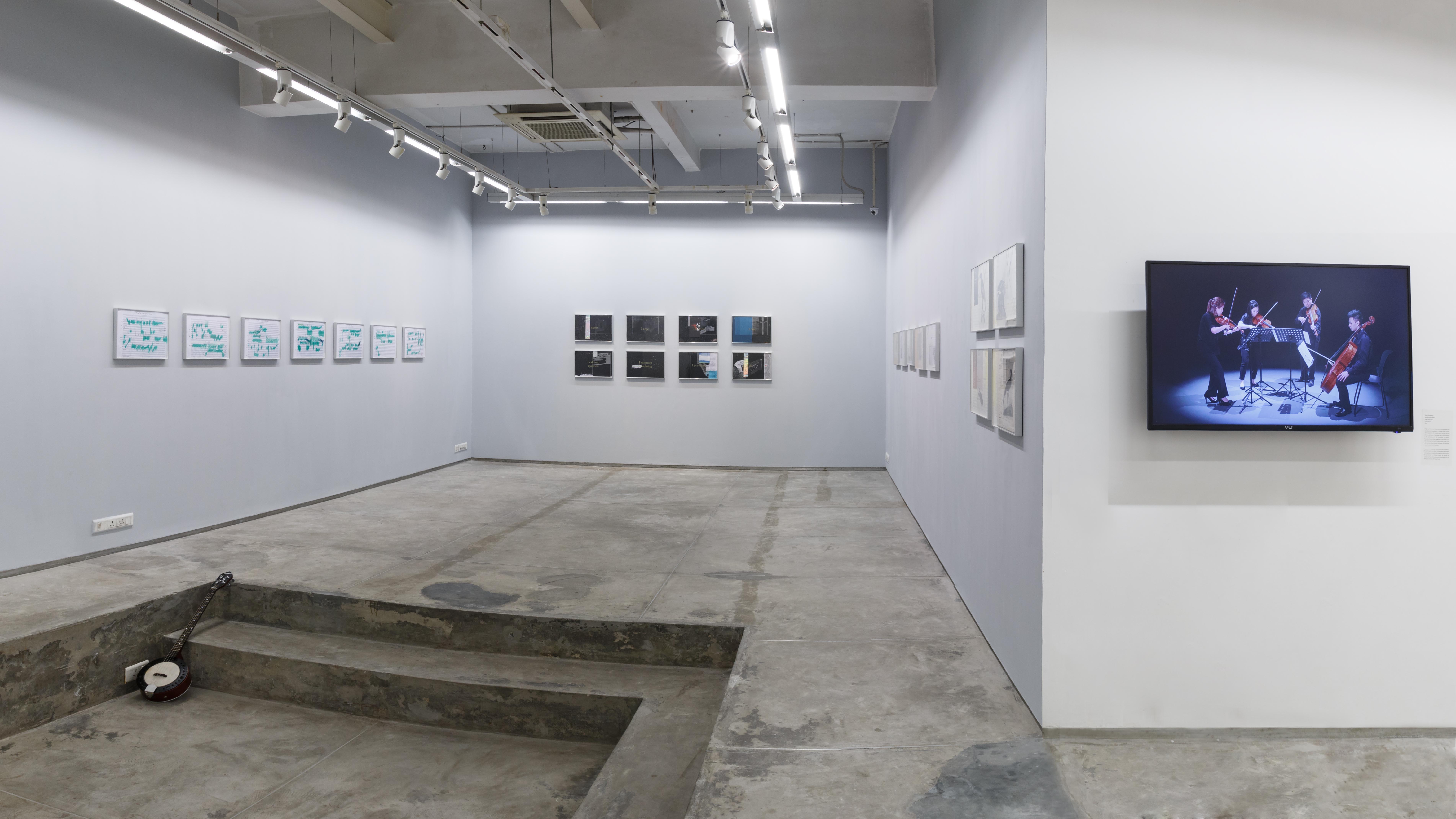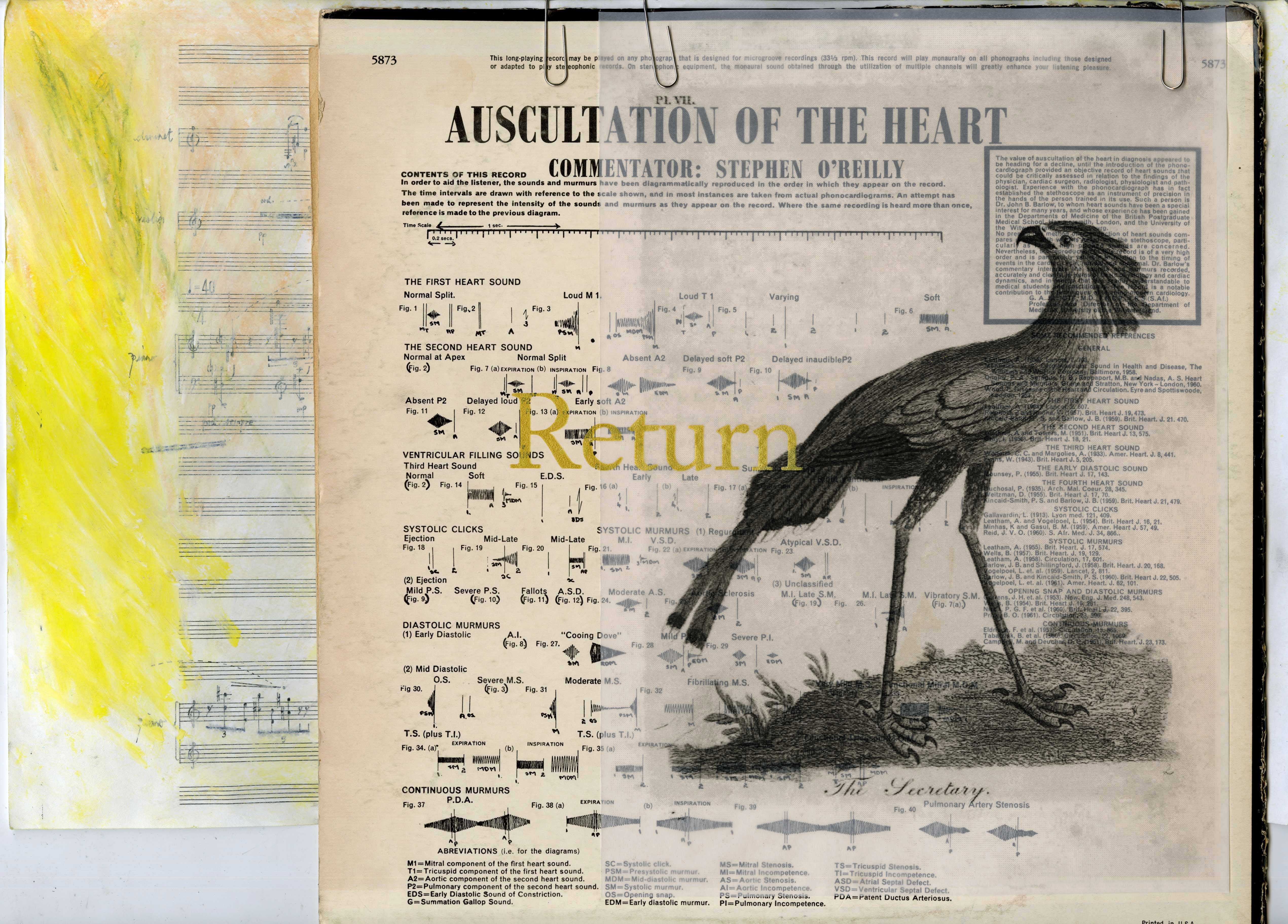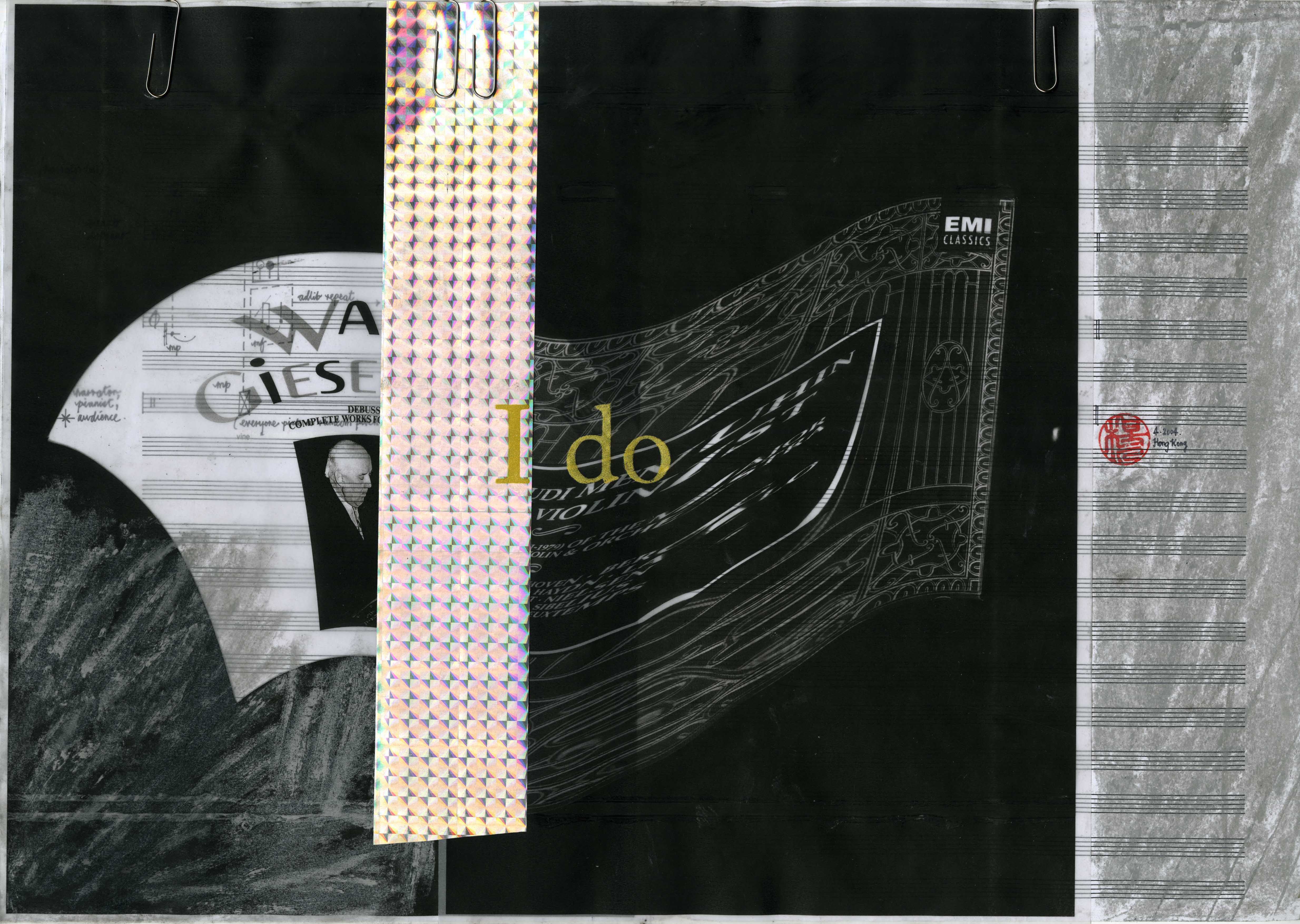“I think if one is honest to oneself, in putting the totality- all of the facets of oneself out there- I think that is how a body of work should look like.” Samson Young speaks to Barnamala Roy.
In his first solo exhibition in India, titled Mastery of Language Affords Remarkable Power, held at The Experimenter Gallery, Kolkata, Samson Young from Hong Kong, explores the notions of margins and centres in paper works, videos and a durational performance. His works, dealing with politically and culturally relevant themes like conflict, identity and borders, are truly multifaceted in the sense that they converge varied mediums. Trained chiefly as a musical composer with a Ph.D. in Music Composition from Princeton University, he constitutes the kaleidoscopic body of his artwork with visual art, audio recordings, radio broadcasts and live performances. He is the inaugural winner of the BMW Art Journey that funded his research, “For Whom the Bell Tolls” which involved traversing across fifteen countries to record the sound of bells.
As I walk into his current exhibition, I encounter musical manuscripts framed on the wall (the musical notes rendered unreadable by green pastel colour) with phrases that seem like incantations- “I validate”, “I authenticate”, “I bestow upon you”, “I call to question”, “I urge”, “I promise” etc. In a section of the gallery two videos from his previously exhibited series Muted Situationsface each other, one featuring a lion dancing troop and the other-a string quartet in performance. The consciously sound-producing constituent of the performances are muted, thereby, revealing natural sounds like breathing of the musicians and the sound their bodies generate.
Fascinated, and admittedly rather baffled, I proceed to have a conversation with Young who is inspecting his frames and exchanging a word or two with the audience.

Your current exhibition is named, Mastery of Language Affords Remarkable Power following the quote from Franz Fanon’s Black Skin, White Masks. What led you to address this issue of language and the cultural hegemony it establishes?
I think, with this title, I aspire to draw a very obvious parallel between what Franz Fanon and other postcolonial theorists have explored in language with the language of music. I mean, it’s a very simple idea but there has not been enough work on this issue in spite of a lot of pretence in calling music the universal language. Musicologists have not tried grappling with it in the same rhetorical vigouras in the case of politics, linguistics or literature.
In context of your foray into language and power, I find you have previously mapped Cantonese phrases onto the piece titled, ‘Memorising the Tristan Chord’ (2013). As I deduce, they are a jumble of puzzling, non-sensical phrases. Is your motif in that piece similar to the present exhibition- an attempt at destabilising something cannonical?
Yes. That sort of question is valid for I have reiterated that in all of my previous works.
Why have you consistently tried destabilising the cannon whether in terms of language, culture, literature or in this case, a musical composition?
I don’t know if the effort has been so much external in terms of destabalising the cannon because there is so little that I can do to make things right. The piece you referred to- ‘The Tristan Chord elaborates on a very personal relation I have with the composer, Richard Wagner and his position in the Western musical education. These are very personal conversations that I keep having in my head and in terms of my work, it is like thinking them out aloud. I don’t believe in consciously destabilizing because that would imply offering the symptom of a disease as the medicine of a disease. So, my attempt is chiefly to process information till I reach a nuanced position without complicating issues.
In ‘To Fanon’- your works on paper for this exhibition, I find that you have reappropriated your original manuscripts by drawing/stamping/colouring/ printing over them. Would you term this seemingly self-coscious act ‘vandalising’?
I wouldn’t call the desecration violence but there is a pain involved in the defacing and effacing in that the manuscripts can then only live on as frames on the wall and I can no longer revisit the musical composition of the manuscripts in the same manner.
For you, does this act (of destroying) follow from the belief that art’s worth shouldn’t be judged by the test of posterity?
No, I don’t think that crossed my mind. It is not a question one has any control over because there are so many things involved in it. The process of canonising something has much to do with the economics, cultural prestige, your race, your gender, your native background, your relationship with the institutions. Since negotiating these are beyond one’s control, so we shouldn’t think about them. For me it is, as I said, more like processing information. Some of these manuscripts are very old, and revisiting them is like diging up skeletons from my closet in terms of what I have done and what they have ended up meaning. Once you have dug them out, you show them. This one I’m looking at, for example (points at a manuscript framed on the wall), embarrases me because the musical composition belongs to a time when I was very self-orientalising in the music I wrote.

What have you used to paint over the notations in this manuscript?
That is soft pastel, covering the bits where the musical notes are. I don’t know, they maybe look like they are being burnt?
What then is the future of these exhibitions if you render the musical compositions non-functional? How do we as an audience revisit them?
Well, now, they have new lives as visual artefacts. I am not embarrassed by the fact that they were music before and now they are just drawings. I guess, in the future when the audience encounters them as art, they will know that there is another layer that is at play which is my personal relationship to these artefacts and how they came about in my mind as musical compositions would perhaps add another dimension to their pleasure in speculating.
How do you locate logic in the audience’s response to your musical-artistic oeuvre? Do you believe in creatively misreading – that every misreading is a new reading?
Yes, I definitely believe that. Misreading is incredibly creative even if we sometimes do not start off with an intentionally creative ethos. It is how we get by.It is how we make certain things, that aren’t working, work. Like, in public transports, your body adjusts in a certain way-creative misreading is basically embodied knowledge by which you understand that you need to talk to this person or that person to make the system work for you. Just that we don’t term it so in day to day activities but is structurally similar to what poets and artists do.
I’ll tell you why I asked you that. In poetry classes at the universities, even when multiple interpretations are said to be valid when engaging in a post-structuralist reading of a certain poem, one is expected to arrive at any interpretation logically. So, do your works invite multiple readings/ mis-readings only within an ambit of logicalness?
No, I don’t think logic is the answer. It comes afterwards- not as a prerequisite that governs all interactions we engage in. And in your case, it is not like logic looms large but there has been an external imposition of it. I believe in playfulness even when exercising logic. Even, children playing in a sand box have their own kind of logic. I think I have been playing games even in these manuscripts.
 In the context of conceptualising landscape in your pieces, I listened to you talk of “flattening time” in one of your videos available online. Could you elaborate on how you conceive of time in your musical pieces?
In the context of conceptualising landscape in your pieces, I listened to you talk of “flattening time” in one of your videos available online. Could you elaborate on how you conceive of time in your musical pieces?
I conceive of time differently in every piece, but in that particular video you mention, I was thinking about the difference between the photograph of a landscape versusthe painting of a landscape. You don’t necessarily think about time in either of the cases but definitely, there is temporality involved in the painting of a landscape because you can’t see everything at once. It’s an illusion but the illusion (that you are only seeing snapshot of one moment) came about from our experience with photography that captures the snapshot of a single moment. Before being conditioned by technology to think so, it wouldn’t have crossed our mind so, the illusion is quite a pretence. It is difficult to compress moments in hearing and if we conceive of landscapes in terms of sound, compression of time, like in the case of photographic snapshots, is not possible to imagine.
I see you did your BA in music, philosophy and gender. Have you contemplated the role of gender in your compositions? For instance in Bengal, even music from the margins like Baul is often relegated to a male domain and the execution of the philosophy it requires is not deemed compatible for women- do you have similar experiences in Hong Kong?
I don’t think I have explicitly covered gender issues in my works. What gender studies gave me was a good foundation in critical theory that led me to focus on notions of things being in the margins.Classical music is still a pretty Euro-centric and male-dominated world. We are lucky because there is an orchestra in Hong Kong – the Hong Kong Sinfonietta – that champions locally-trained musicians. The other publicly-funded orchestra in the city (the Hong Kong Philharmonic)has a much longer history, but was notorious for not hiring local musicians, composers and conductors. That’s in fact the reason that the Hong Kong Sinfonietta was founded– so that locally-trained musicians could find employment when they graduate. I think about how the Americans negotiate their relationship with classical music and how, in contrast, we- meaning those of us living in Asia -consider our relationship with classical music, and why we invest so much of our public funds on preserving and promoting classical music. How have we established our imagined connection to this very specific history of music making? These may seem super-obvious questions to ask, but to address these issues is to destabilize the pedagogy of classical music to its core.
Your work, ‘The Anatomy of a String Quatret’ reconfigures the body of the musician. Do you think the artist/musician’s body is of significance only during its appropriation for the length of a performance or is it crucial even beyond the performance for articulating the artist’s persona?
Of course, their body has value outside the performance but when I am intervening and coming into the situation as a composer or an artist, I only have control over that length of time spanning the performance. It would be arrogant to assume that I can have control beyond that.I have many hats. I wear a hat as an artist and a composer and there is a very specific time and space when i need to feel responsible for that. Another hat is that I’m a citizen, in another I’m son- so, in all of these hat, the ethics is negotiated in very different ways.You need to think of them as various pockets of time and spacebut they effect each other.They cross-germinate and make me who I am. There is more than one of me- there are multiple me-s.
Your work seems to flow seamlessly from art to music, from music to art. In the BMW art journey video, I find you focused on transforming sound into visuals to find an answer to the question ‘For Whom the Bell Tolls’. Again, in ‘What the Lighthouses Taught Me’, you seem to draw with pencil, colour pencil, water colour, pastel and stamp on paper on your journey perhaps to discover music. So, could you give us a little insight into your creative process? Do you conceptualise and formulate the musical notes as you do your sketches or is it the other way round?
In these case, I would say, chiefly improvisation. ‘For Whom the Bell Tolls’ is a research project, so it is more open-ended and does not conclude into any specific model of work. When you are recording bells, you can’t just say -“oh, I want to make the recording now”.You have to wait for the bell to ring. The bell doesn’t toll for you, it tolls for everyone. Why I resort to drawing is partly because it gave me something to do as I waited for the bells to toll.
Are you trained as a painter?
No, I am only trained as a composer in music and neverhad any formal training in the visual arts.
So you just incorporated art into your process?
Yes, but it has been a very long process. I started collaborating with groups of artists- there would be musicians, painters, poets and we would each contribute our expertise and then practice swapping roles. So that was very crucial educational process for me. It also contains that playful attitude that I referred to earlier. I mean, it is not like you should not be serious, but a certain frivolity ought to accompany your experimentations. That is how I am as person- Idont pigeonhole anything as my craft- I shamelessly dive into areas I have little idea about.
Yes, it is very difficult to categorise your work. They cannot be identified by a single ideology, they are intertextual and interdisciplinary in a truly postmodern spirit. How would you yourself define your work?
They are like how I am. I am very curious. I’m not consistent as a person but I like to make stuff. I’m ill-informed often and I contradict myself. I am sensitive and appreciative to what is happening around. I think if one is honest to oneself, in putting the totality- all of the facets of oneself out there- I think that is how a body of work should look like.I’m also drawn to artists like that. John cage,Yoko Ono and Nam Jun Paik, for example.Those who are visionary in what they have created but grossly inconsistent.
 Much as we would like to be surprised by your upcoming works, would you give us an idea about what you are planning next?
Much as we would like to be surprised by your upcoming works, would you give us an idea about what you are planning next?
I’m making a soundwork next. It is a big topic but I’m looking at how people experience fear and anxiety and what they do to make themselves feel better. I’m using smoking tobacco as a metaphor and it is loosely based on the novel, The Ministry of Fear that came out before the end of the second world war.
Do you plan to work on environmental crisis issues sometime in the future?
No, I have been dealing with conflict as a theme for several years now which I would like to explore further before taking up such a huge issue.













